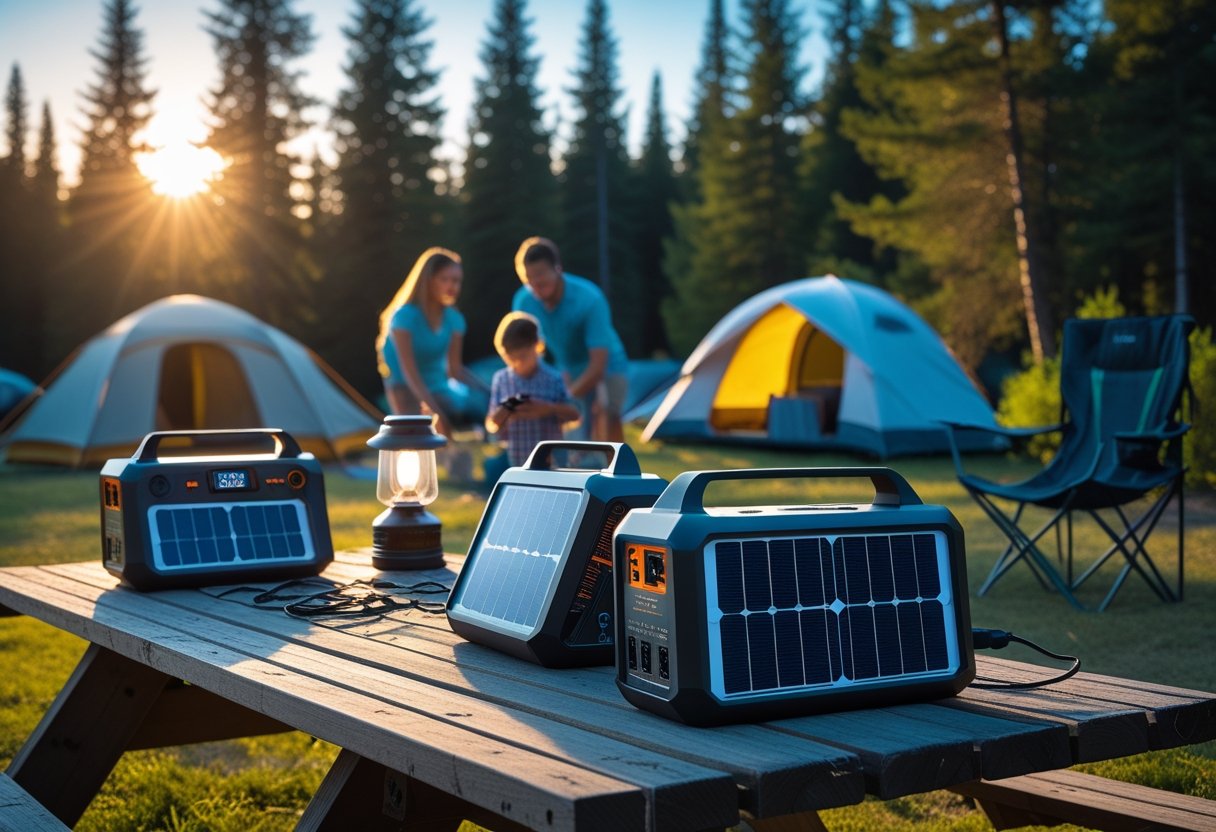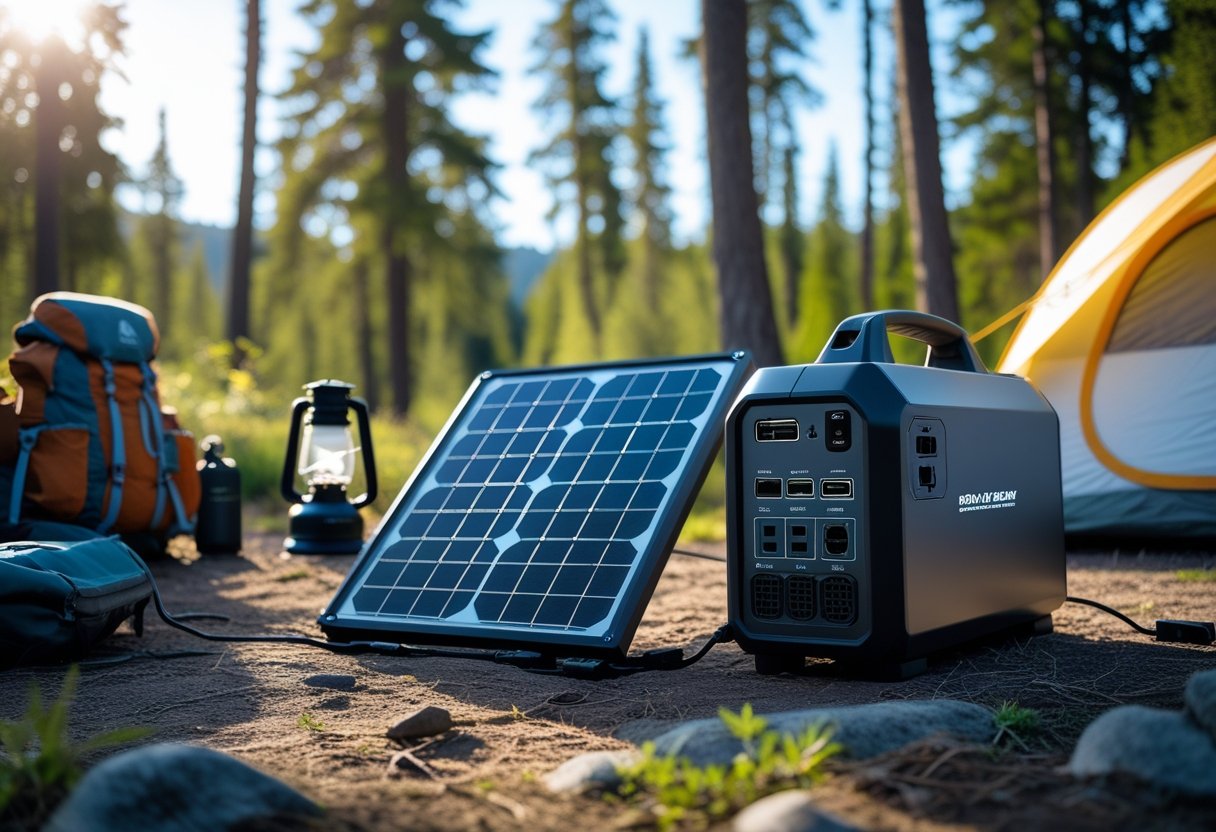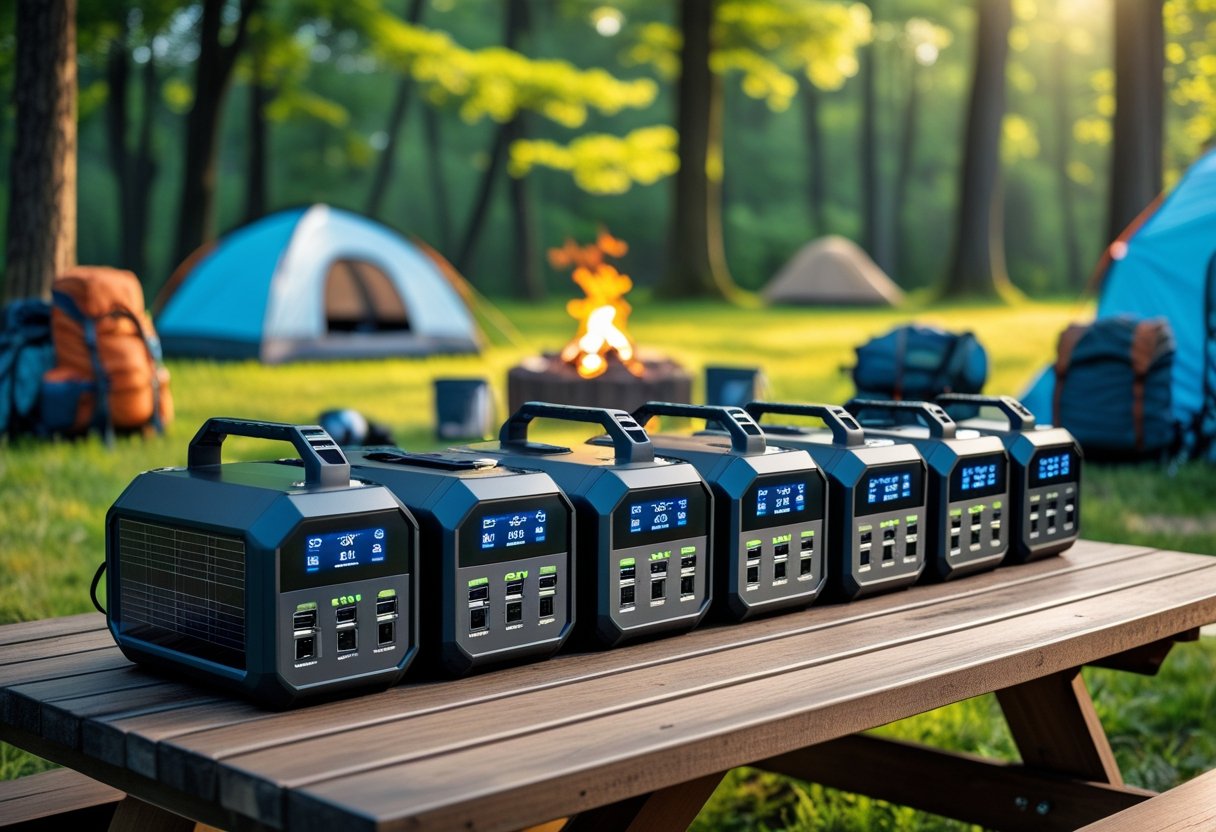Camping often requires reliable power for devices and small appliances, and portable solar generators offer a clean, quiet, and convenient solution. They combine solar panels with battery storage, allowing users to charge devices off-grid without relying on fuel or noisy traditional generators. The best portable solar generators for camping balance capacity, weight, and solar input efficiency to provide dependable power in remote locations.

These units vary widely in output and features, catering to different needs, from charging phones and lights to running small refrigerators or medical devices. Popular models from brands like Jackery, EcoFlow, and Goal Zero are known for their durability and performance, making them top choices for campers seeking reliable energy solutions.
Selecting the right solar generator depends on factors such as power capacity, portability, and solar panel compatibility. Users should consider how much power they need and how often they can recharge via sunlight, ensuring their generator fits their specific camping style and duration. For detailed reviews, models like the Jackery SolarSaga 100 and EcoFlow DELTA 2 represent some of the best options available in 2025.
Understanding Portable Solar Generators

Portable solar generators are compact power systems designed to harness solar energy efficiently. They integrate multiple components to store and convert energy, providing reliable electricity in remote or off-grid locations. Their design focuses on capacity, compatibility, and ease of use for outdoor activities like camping.
What Is a Portable Solar Generator?
A portable solar generator is a self-contained unit that captures sunlight via solar panels and converts it into usable electrical power. Unlike traditional gas generators, it operates silently without fuel, making it suitable for quiet outdoor environments.
These generators include batteries to store energy for use when sunlight is unavailable. Users can connect devices directly or through outlets included in the generator unit. Portability is key, so many models are lightweight with handles or wheels for easy transport.
Key Components: Battery, Inverter, and Charge Controller
The battery is central to capacity and runtime, typically lithium-ion for better energy density and lifespan. It stores the solar energy collected throughout the day.
The inverter converts stored DC energy in the battery to AC power compatible with most camping devices and appliances. Its wattage rating determines what devices the generator can power simultaneously or sequentially.
The charge controller manages the energy flow from solar panels to the battery, preventing overcharging and optimizing battery health. Some models feature MPPT (Maximum Power Point Tracking) controllers, which improve efficiency.
| Component | Function | Importance |
|---|---|---|
| Battery | Stores energy | Determines overall runtime |
| Inverter | Converts DC to AC | Powers regular AC devices |
| Charge Controller | Regulates voltage and current charging | Protects battery and improves efficiency |
Benefits of Portable Solar Generators for Camping
Portable solar generators provide clean, renewable power without noise or emissions, making them ideal for camping where maintaining a natural setting is preferred.
They offer flexibility with various input/output options, including USB, AC outlets, and 12V DC ports, allowing charging of phones, laptops, lights, and small appliances. Their ability to recharge from solar panels during the day extends usage without depending on fuel.
Battery capacity and inverter size vary, giving campers options to match generator size to their power needs. Additionally, modern models are designed for easy setup and transport, balancing weight with power output. Portable solar systems enable off-grid power with less hassle compared to traditional generators.
More about portable solar power options can be found at this guide to portable solar power.
How to Choose the Best Portable Solar Generator
Selecting a portable solar generator requires understanding its power capabilities, size and weight, and how it charges. These factors determine how well the generator can support devices during camping and how easily it moves with the user.
Power Output and Battery Capacity
The power output, measured in watts, indicates how much energy the generator can deliver at once. For camping, a typical range is 200 to 1000 watts, enough to run small appliances, lights, and charge phones or laptops. Battery capacity, usually listed in watt-hours (Wh), shows how long the generator can supply power. Higher capacity means longer usage between charges.
Look for models with multiple AC outlets, DC outputs, and USB ports. This variety allows connection to different devices without adapters. For example, a generator with 500 Wh battery capacity and 300W power output can charge smartphones and run mini fridges but might not support a coffee maker. Power needs depend on the devices planned for use.
Portability and Weight Considerations
Portability is critical for camping. Generators labeled as lightweight or compact are easier to carry over distances. A solar generator around 10 to 20 pounds balances capacity with portability for most users. Bulky or heavy units can become a burden on hikes or when packing gear.
Integrated handles, rugged casing, and the ability to fold or detach portable solar panels also enhance mobility. Solar panels are usually rated separately but need to match the generator’s input to charge efficiently. Choosing portable solar panels that fold or collapse improves convenience. A lightweight setup reduces fatigue and streamlines packing.
Charging Options and Compatibility
Generators should support multiple charging methods—solar panels, AC wall outlets, and car chargers—for flexibility. Solar panels designed for the generator will maximize charging speed; mismatched panels may charge slower.
Check compatibility with the generator’s input ports, often MC4 or Anderson connectors. Some models allow pass-through charging, powering devices while recharging simultaneously. Faster charging boosts usability during short daylight hours.
Devices with USB ports, AC outlets, and DC outputs can connect directly without adapters if the generator supports them. Compatibility ensures seamless integration and fewer accessories to carry. For detailed testing and reviews, see examples of the best solar generators of 2025.
Top-Rated Portable Solar Generators for Camping

Selecting a portable solar generator for camping requires balancing power capacity, weight, and durability. Different models cater to varied needs, from lightweight charging to long-term boondocking. Features such as battery type, output options, and build quality directly affect camping convenience and reliability.
Best Overall Portable Solar Generator
The best overall portable solar generator combines a robust battery, versatile outputs, and ease of use. Models using LiFePO4 batteries are preferred for their longer lifespan and safety, especially when camping off the grid. They generally offer multiple AC, DC, and USB ports to power a variety of devices.
A top choice offers around 500-700Wh capacity to run essentials like lights, small appliances, and phones for several hours. It should also have a well-designed interface for monitoring battery health and input/output status. Reliable charging options, including fast solar input and car adapters, enhance flexibility. Look for brands with strong user reviews confirming real-world performance and durability.
Lightweight and Compact Models
For day trips or minimalist campers, lightweight solar generators around or under 200Wh are ideal. These compact units usually weigh less than 10 pounds, making them easy to carry on hikes.
Efficiency and solar panel compatibility are priorities to quickly replenish the battery during limited sunlight. Ideal devices support foldable solar panels like the Jackery SolarSaga or integrative setups from EcoFlow. Although their power capacity limits running larger electronics, they excel at charging phones, GPS units, and small fans. Quick setup and transport are crucial factors in this category.
High-Capacity Generators for Extended Trips
Extended camping or boondocking demands high-capacity solar generators with at least 1000Wh of storage. These power stations often feature LiFePO4 batteries or advanced lithium-ion packs to ensure long cycle life and consistent output.
They can run heavier equipment, including mini fridges, power tools, and lights, over multiple days without recharging. Multiple AC outlets and high-wattage support (over 1000W) allow simultaneous device operation. Larger solar input capacity enables faster recharging, crucial in remote locations. Weight and size increase with capacity, so users should consider transport logistics and the generator’s durability rating.
Durable Options for Off-the-Grid Adventures
Durability is essential for users spending extensive time off the grid or in rugged environments. Portable solar generators with reinforced casings, dust and water resistance, and shockproof designs withstand harsh conditions better.
Look for IP-rated models designed for outdoor exposure and rough handling. High-quality brands often reinforce ports and incorporate sturdy handles for easier transport during backcountry or boondocking trips. These generators maintain reliability even after repeated use in challenging weather. Battery type also influences durability, with LiFePO4 systems favored for stable temperature tolerance and longer lifecycle performance in adverse conditions.
Best solar generators often blend these qualities to ensure campers remain powered regardless of environment.
Important Usage and Maintenance Tips
Proper use and upkeep of portable solar generators extend their lifespan and ensure reliable power during camping trips. Efficient charging, appropriate appliance use, and understanding warranty and support options are key to optimizing the experience.
Maximizing Efficiency and Charging Time
To reduce total charging time, solar generators should be placed in direct sunlight, ideally with solar panels angled toward the sun. Partial shade or cloudy conditions significantly decrease power intake, extending charging periods.
Users should monitor battery levels and avoid letting the generator drain fully, as this can reduce battery longevity. Connecting additional compatible solar panels can increase charging speed for models that support expansion.
Temperature affects performance; extreme cold or heat can decrease battery efficiency. Storing the generator in moderate climates and protecting it from the elements can mitigate this. Careful transport limits physical damage, which can impair internal components and charging capability. More detailed tips are available through a portable solar generator maintenance guide.
Running Appliances and Devices
Solar generators provide steady power but have limits based on wattage capacity. They are suitable for charging phones, running LED lights, small fans, or laptops. Using them for high-draw appliances like heaters or gas stoves is inefficient and may quickly drain the battery.
Understanding the wattage requirements of devices is critical. Running multiple devices simultaneously should stay within the generator’s output rating to avoid overload. Users should prioritize low-power, essential gear to maximize runtime during camping.
For internet devices like Starlink, ensuring the generator has enough capacity can maintain connectivity in remote areas. Compared to gas generators, solar units operate quietly and produce no emissions, benefiting outdoor air quality and addressing concerns related to climate change and pollution.
Customer Service and Warranty Considerations
Reliable customer service is important when selecting a solar generator, as it addresses potential issues like battery faults or charging failures. Checking the warranty length and what it covers helps avoid unexpected costs.
Most leading brands offer at least a 12-month warranty covering manufacturing defects. Some provide extended coverage or service plans. Responsive support teams can assist with setup questions or troubleshooting.
When comparing solar generators to gas alternatives, the lower maintenance and absence of fuel-related problems often make solar preferable. Accessing manufacturer support ensures long-term satisfaction, especially in areas prone to power outages where dependable backup power is needed. For further details, see solar power customer service and warranty advice.
Top Pick: Jackery Explorer 1000
Reliable, portable, and powerful — ideal for blackouts, camping, and off-grid living.
Check Price on Amazon →